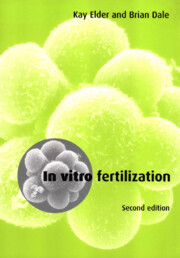Book contents
- Frontmatter
- Contents
- Preface
- Acknowledgments
- 1 Introduction
- 2 Producing gametes
- 3 Sperm–oocyte interaction
- 4 First stages of development
- 5 Endocrine control of reproduction
- 6 Assisted reproductive technology in farm animals
- 7 The clinical in vitro fertilization laboratory
- 8 Semen analysis and preparation for assisted reproductive techniques
- 9 Oocyte retrieval and embryo culture
- 10 Cryopreservation
- 11 Micromanipulation techniques
- 12 Preimplantation genetic diagnosis
- Index
6 - Assisted reproductive technology in farm animals
Published online by Cambridge University Press: 15 August 2009
- Frontmatter
- Contents
- Preface
- Acknowledgments
- 1 Introduction
- 2 Producing gametes
- 3 Sperm–oocyte interaction
- 4 First stages of development
- 5 Endocrine control of reproduction
- 6 Assisted reproductive technology in farm animals
- 7 The clinical in vitro fertilization laboratory
- 8 Semen analysis and preparation for assisted reproductive techniques
- 9 Oocyte retrieval and embryo culture
- 10 Cryopreservation
- 11 Micromanipulation techniques
- 12 Preimplantation genetic diagnosis
- Index
Summary
Artificial insemination
Artificial insemination (AI) has for many years been the predominant method used to increase reproductive potential in agriculture. Although practised in many species, this technique is particularly useful in cattle, where the costbenefit over natural mating is substantial. In many western countries, the majority of cattle are inseminated artificially. The most common method of semen collection involves the use of an artificial vagina which is designed to simulate natural conditions. This consists of a rigid cylindrical case with a rubber liner, which is lubricated on the inner surface. The space between liner and case is filled with warm water, usually at 40–45°C, and pressure adjustments may be made by inflating with air. When the male mounts a dummy female the penis is deflected by the operator into the artificial vagina and the ejaculate is collected in a suitably heated receptacle. An alternative method, for use with difficult or young males being taught to mount dummies, is electroejaculation using a rectal probe.
There are significant species differences in the volume of semen and the total number of spermatozoa in an ejaculate. The boar, owing to its large testis and to the short duration of its spermatogenic cycle, produces up to 500ml of semen containing 45×109 of spermatozoa (1×108/ml) and can produce even larger volumes of up to 1500 ml. The bull, in contrast, produces an average of 5ml of semen with a concentration of up to 7×109/ml.
- Type
- Chapter
- Information
- In Vitro Fertilization , pp. 93 - 108Publisher: Cambridge University PressPrint publication year: 2000
- 1
- Cited by



